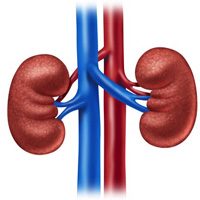Stone free rate and clinical complications in patients submitted to retrograde intrarenal surgery (RIRS): Our experience in 571 consecutive cases

Accepted: May 7, 2021
All claims expressed in this article are solely those of the authors and do not necessarily represent those of their affiliated organizations, or those of the publisher, the editors and the reviewers. Any product that may be evaluated in this article or claim that may be made by its manufacturer is not guaranteed or endorsed by the publisher.
Introduction: The purpose of this study is to report the stone free rate (SFR) and clinical complications in patients submitted to retrograde intrarenal surgery (RIRS).
Materials and methods: A total of 571 procedures of upper urinary stones treated using flexible ureteroscopy and holmium laser lithotripsy from January 2014 to February 2020 have been analyzed. Overall SFR was evaluated after 3 months following the procedure by means of a non-contrast computed tomography. Success was considered as stone-free status or ≤ 0.4 cm fragments.
Results: The overall SFR was 92.3% in group 1 (stone size: < 1 cm), 88.3% in group 2 (stone size: > 1 ≤ 2 cm), 56.7% in group 3 (stone size: 2-3 cm) and 69.6% in group 4 (multiple stones). Post-operative complications, according to the Clavien- Dindo (CD) classification system, were recorded in 32 (5.6%) procedures. The major complications recorded were: one case of subcapsular hematoma (SRH) associated with pulmonary embolism two days after the procedure (CD Grade IIIa) treated conservatively and one case of hemorrhagic shock 2 hour with multiple renal bleedings requiring urgent nephrectomy (CD Grade IVA).
Conclusions: The RIRS is an effective and safe procedure with a high SFR significantly correlated with the stone size; at the same time, RIRS could be characterized by severe clinical complications that require rapid diagnosis and prompt treatment.
Tiselius HG, Alken P, Buck C, et al: Guidelines on urolithiasis. Arnhem, the Netherlands: Euro-pean Association of Urology 2008.
Türk C, Knoll T, Petrik A, et al: EAU Guidelines. Urolithiasis 2013.
Bas O, Bakirtas H, Sener NC, et al: Comparison of shock wave lithotripsy, flexible ureteroreno-scopy and percutaneous nephrolithotripsy on moderate size renal pelvis stones. Urolithiasis 2014; 42: 115-20. DOI: https://doi.org/10.1007/s00240-013-0615-2
Knoll T, Jessen JP, and al: Flexible ureterorenoscopy versus miniaturized PNL for solitary renal calculi of 10-30 mm size World J Urol 2011; 29: 755-59. DOI: https://doi.org/10.1007/s00345-011-0784-y
Dindo D, Demartines N and Clavien PA: Classification of surgical complications. A new pro-posal with evaluation in a Cohort of 6336 patients and results of survey. Ann Surgery 2004; 2: 205-213. DOI: https://doi.org/10.1097/01.sla.0000133083.54934.ae
Traxer O, Thomas A: Prospective evaluation and classification of ureteral wall injuries resulting from insertion of a ureteral access sheath during retrograde intrarenal surgery. J Urol 2013; 189: 580-84. DOI: https://doi.org/10.1016/j.juro.2012.08.197
Elbir F, Başıbüyük İ, Topaktaş R, et al: Flexible ureterorenoscopy results: Analysis of 279 cases. Turk J Urol 2015; 41: 113-18. DOI: https://doi.org/10.5152/tud.2015.81488
Breda A, Angerri O: Retrograde intrarenal surgery for kidney stones larger than 2.5 cm. Curr Opin Urol 2014; 24:179-83. DOI: https://doi.org/10.1097/MOU.0000000000000030
Breda A, Ogunyemi O, Leppert JT, et al: Flexible ureteroscopy and laser lithotripsy for multiple unilateral intrarenal stones. Eur Urol 2009; 55: 1190-96. DOI: https://doi.org/10.1016/j.eururo.2008.06.019
Riley JM, Stearman L, Troxel S: Retrograde ureteroscopy for renal stones larger than 2.5 cm. J Endourol 2009; 23: 1395-8.
Hyams ES, Munver R, Bird VG, Uberoi J, Shah O: Flexible ureterorenoscopy and holmium la-ser lithotripsy for the management of renal stone burdens that measure 2 to 3 cm: a multi-institutional experience. J Endourol 2010; 24:1583-88.
Cindolo L, Castellan P, Scoffone CM, et al: Mortality and flexible ureteroscopy: analysis of six cases. World J Urol 2016; 34: 305-10. DOI: https://doi.org/10.1007/s00345-015-1642-0
Cindolo L, Castellan P, et al: Life-threatening complications after ureteroscopy for urinary stones: survey and systematic literature review. Minerva Urologica e Nefrologica 2017; 69: 421-31. DOI: https://doi.org/10.23736/S0393-2249.17.02787-4
Kourambas J, Byrne RR, Preminger GM: Does a ureteral access sheath facilitate ureteroscopy? J Urol 2001; 165: 789-93. DOI: https://doi.org/10.1016/S0022-5347(05)66527-5
Karaaslan M, Tonyali S, Yilmaz M, et al. Ureteral access sheath use in retrograde intrarenal surgery. Arch Ital Urol Androl. 2019;91:112-114. DOI: https://doi.org/10.4081/aiua.2019.2.112
Rapoport D, Perks AE, Teichman JM. Ureteral access sheath use and stenting in ureteroscopy: effect on unplanned emergency room visits and cost. J Endourol. 2007; 21:993-97. DOI: https://doi.org/10.1089/end.2006.0236
De S, Autorino R, Kim FJ, et al. Percutaneous nephrolithotomy versus retrograde intrarenal surgery: a systematic review and metaanalysis. Eur Urol. 2015; 67:125-37. DOI: https://doi.org/10.1016/j.eururo.2014.07.003
Bai J, Li C, Wang S, et al. Subcapsular renal haematoma after holmium:yttrium-aluminum-garnet laser ureterolithotripsy. BJU Int. 2012; 109:1230-41. DOI: https://doi.org/10.1111/j.1464-410X.2011.10490.x
Tao W, Cai CJ, Sun CY, et al. Subcapsularrenal hematoma after ureteroscopy with holmium:yttrium-aluminum-garnet laser lithotripsy. Lasers Med Sci. 2015; 30:1527-32. DOI: https://doi.org/10.1007/s10103-015-1760-3
Hyams ES, Munver R, Bird VG, et al. Flexible ureterorenoscopy and holmium laser lithotripsy for the management of renal stone burdens that measure 2 to 3 cm: a multi-institutional experience. J Endourol. 2010;24:1583-88. DOI: https://doi.org/10.1089/end.2009.0629
Riley JM, Stearman L, Troxel S. Retrograde ureteroscopy for renal stones larger than 2.5 cm. J Endourol. 2009;23:1395-98. DOI: https://doi.org/10.1089/end.2009.0391
Di Mauro D, La Rosa VL, Cimino S, Di Grazia E. Clinical and psychological outcomes of patients undergoing Retrograde Intrarenal Surgery and Miniaturised Percutaneous Nephrolithotomy for kidney stones. A preliminary study. Arch Ital Urol Androl. 2020; 91:256-260. DOI: https://doi.org/10.4081/aiua.2019.4.256
Nuttall MC, Abbaraju J, Dickinson IK, et al. A review of studies reporting on complications of upper urinary tract stone ablation using the holmium:YAG laser. Br J Med Surg Urol. 2010; 3:151-59. DOI: https://doi.org/10.1016/j.bjmsu.2010.01.008
PAGEPress has chosen to apply the Creative Commons Attribution NonCommercial 4.0 International License (CC BY-NC 4.0) to all manuscripts to be published.


 https://doi.org/10.4081/aiua.2021.3.313
https://doi.org/10.4081/aiua.2021.3.313



